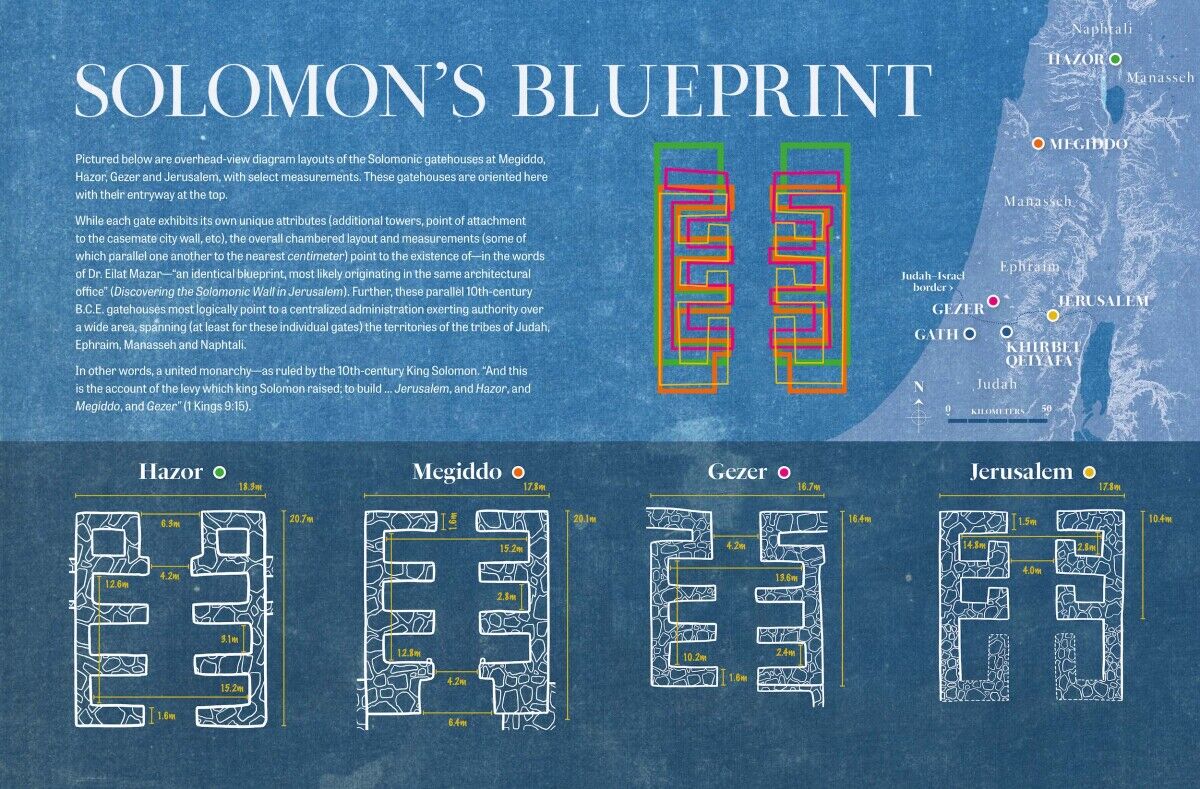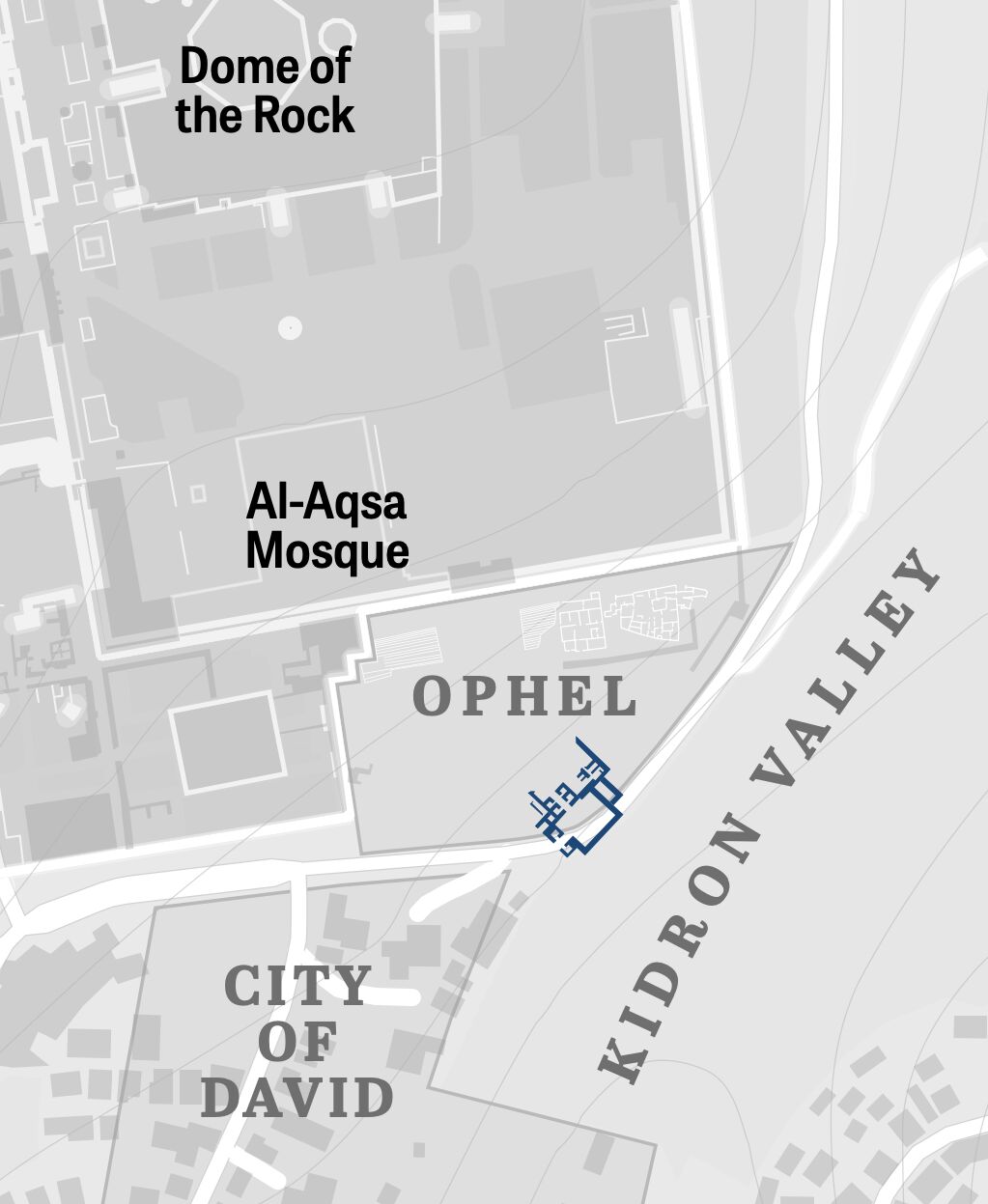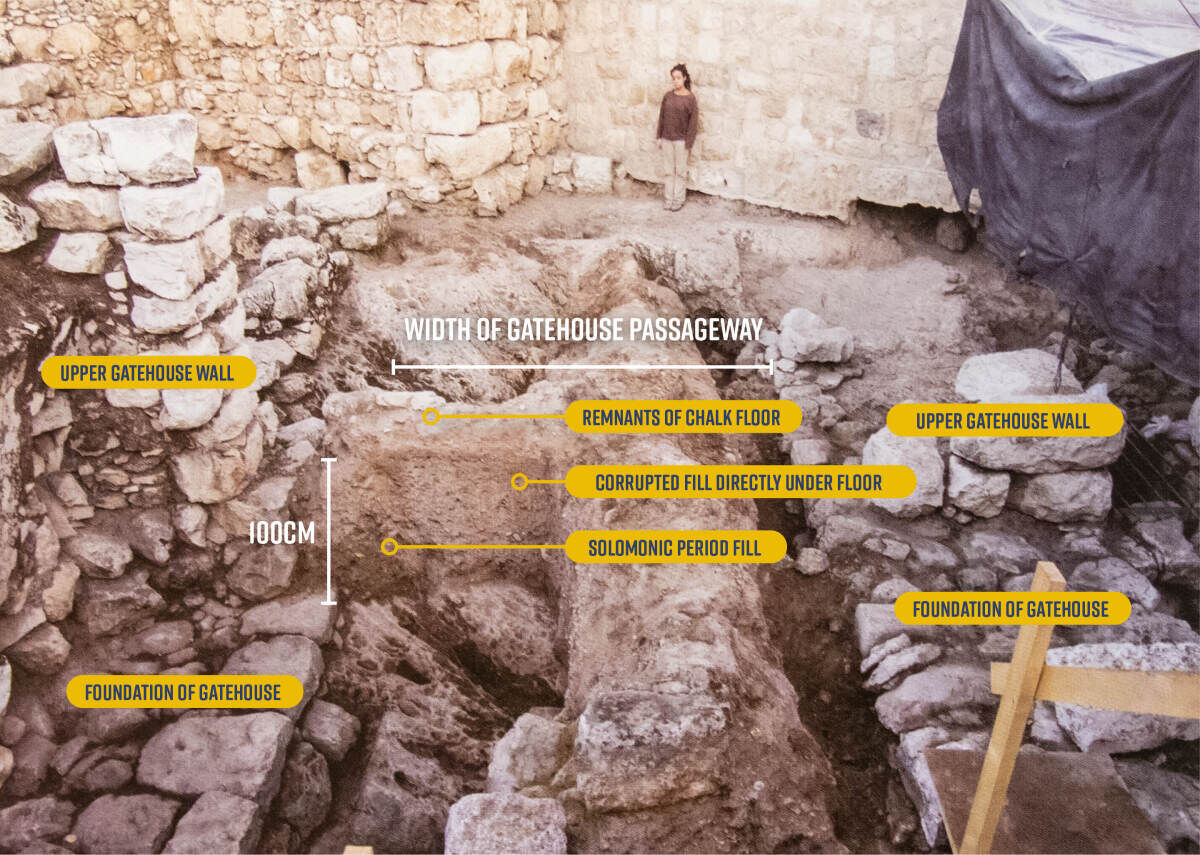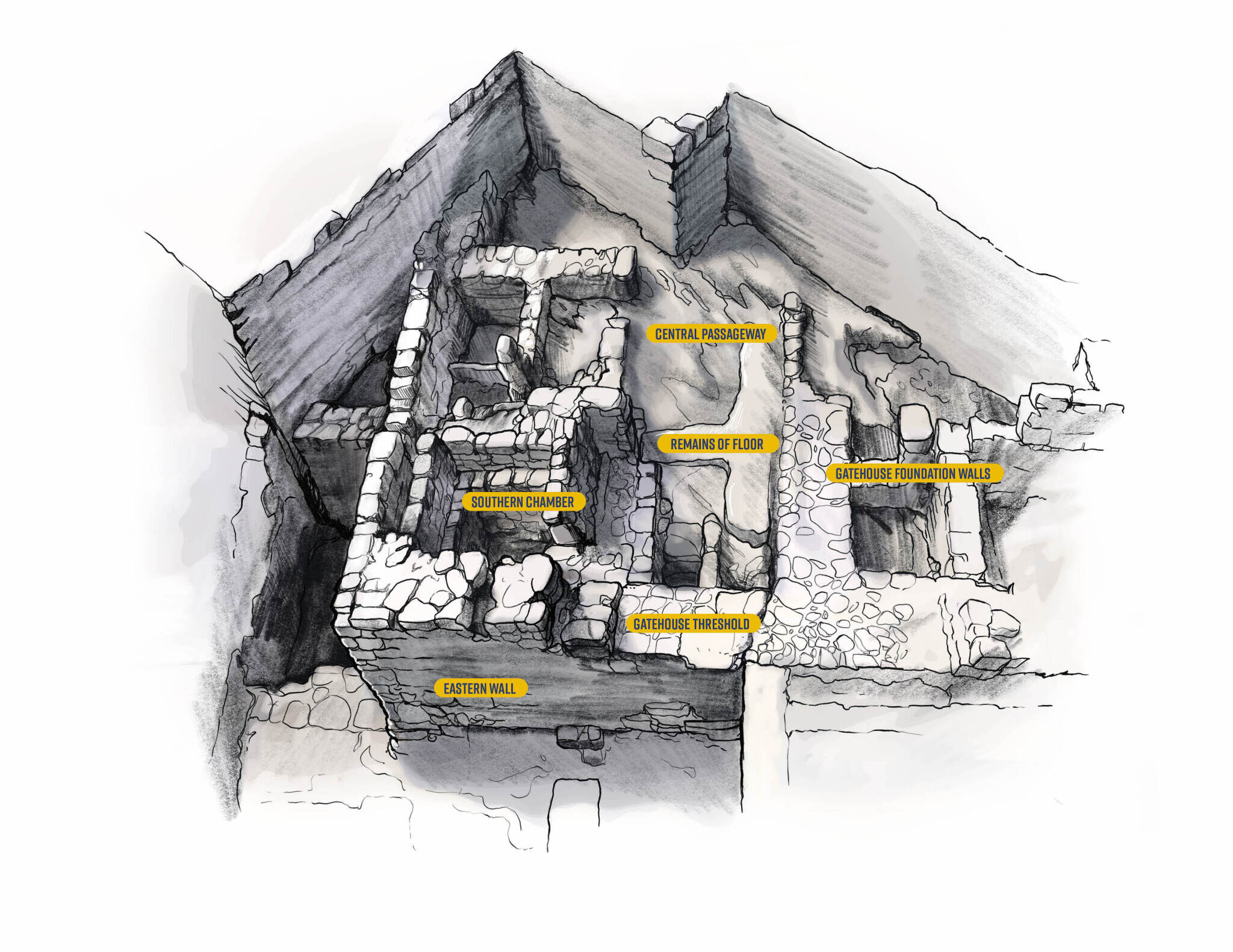The late Jerusalem archaeologist Dr. Eilat Mazar made some spectacular and historic discoveries. There’s the tiny clay bulla inscribed with the name of Judah’s King Hezekiah, the trove of gold coins and medallion, and Nehemiah’s hastily built wall, to name a few. In 2005, Dr. Mazar captured the imaginations of millions around the world when she announced that she had uncovered archaeological evidence of the palace of King David.
All of these discoveries have been written about, in many cases, at great length and with great fanfare. Did you know Dr. Mazar uncovered another sensational find, one that is as grand and impressive, at least archaeologically, as David’s palace? This find has barely been reported on in the media. Even within the archaeological community, it has become a distant memory.
She made this discovery in 1986, a full 19 years before she uncovered King David’s palace. It was made during the excavation of a site about 150 meters north of the City of David, in the southeast section of the Ophel. Here, Dr. Mazar uncovered what she came to believe was a monumental gatehouse from the time of King Solomon.
One reason Dr. Mazar’s Solomonic gatehouse hasn’t made a splash is because it was uncovered in stages. In the 1980s, when she first uncovered the partial remains of the gatehouse, Mazar dated them to the ninth century b.c.e.—not to the 10th century, the time of King Solomon. At the time, she didn’t believe there was enough evidence to date the gatehouse to the time of Solomon.
This speaks to Dr. Mazar’s scientific integrity and modesty. If she had been driven by an agenda or a longing for the spotlight (as she is sometimes accused of), she could have reasonably suggested early on that the gatehouse belonged to King Solomon. But Mazar, not wanting to get ahead of the science, refrained.
This view changed in 2009, when Dr. Mazar returned to the Ophel to continue excavations on the gatehouse. At the end of the 2009 excavation, she examined the new information and findings alongside the information and evidence from prior excavations. With more of the gatehouse now exposed, and with more information at her disposal and a better understanding of the overall site, Dr. Mazar was in a position to reexamine the dating of the gatehouse. It wasn’t until 2009 that she believed this impressive structure was actually from the time of King Solomon.

Unsurprisingly, not everyone agreed. Even today, there is debate about the dating of the Ophel gatehouse. The ramifications of this debate are not insignificant. If this gatehouse was, as Dr. Mazar advocated, built by Solomon, then it is compelling evidence disproving the minimalist’s view that King Solomon was an insignificant tribal ruler and that Jerusalem in the 10th century b.c.e. was merely a village.
If Dr. Mazar’s gatehouse does in fact belong to King Solomon, then it is evidence supporting the biblical description of King Solomon as a great monarch who ruled a powerful kingdom.
So, what does the archaeology tell us? Does this gatehouse belong to King Solomon?
Excavating Jerusalem
Of all the places on Earth to dig, excavating Jerusalem—especially the earlier archaeological periods—is incredibly complex and challenging. First, there’s the political and religious sensitivity and tension. Second, modern Jerusalem is densely populated and intensely developed. If you want to dig, especially in ancient Jerusalem, the site very likely sits beneath some sort of building or road.
Finally, there’s the archaeological complexity. Many areas of Jerusalem, especially the oldest parts, have been the territorial home of multiple civilizations. Historically, when one civilization replaced another, the new civilization often demolished the one it was replacing. History books record that some rulers, such as King Herod, literally razed parts of Jerusalem to make way for new construction. In other instances, the new civilization would integrate its infrastructure with previous civilizations’ infrastructures. In some parts of Jerusalem, there is archaeological evidence of more than 20 distinct construction levels, the earliest of which date to the early second millennium b.c.e.
The City of David and the Ophel are in the oldest parts of Jerusalem, and the most archaeologically challenging to excavate.
The area encompassing the Ophel gatehouse was first excavated in 1976, and then again in ’86, ’87, ’94 and 2009. During these digs, which were led by either Prof. Benjamin Mazar or Dr. Eilat Mazar, multiple distinct walls were uncovered. The dating of these walls varies and spans 1,500 years of civilization. One of the main tasks (and challenges) of the archaeologist is to identify the walls and then determine each wall’s date of construction.
As the site is excavated and more detail is exposed and studied, you can begin to see how the walls and various layers interact. A stratigraphic sequence of construction develops. The layers of earth (“floors”) are also studied. If possible, it’s extremely helpful to know whether a floor reaches all the way to a wall. Like a jigsaw puzzle, all of these details come together to reveal the history of the site.
In the very first phases of excavation, Dr. Mazar learned that the earliest walls of the Ophel gatehouse were constructed during the Iron ii period. Also termed the First Temple Period, this archaeological era is generally dated from around 1000 to 586 b.c.e. (the time of Jerusalem’s destruction).
When considering the Ophel’s Iron ii walls, it’s important to remember that we are looking at partial walls. Many of the First Temple remains in the area were destroyed by subsequent civilizations. On this site, we have evidence of Hasmonean, Herodian, Late Roman and Byzantine civilizations, all of which dug down to bedrock.

However, while there may not be acres of well-preserved Iron ii walls, there is clear evidence of Iron ii civilization. Using the evidence, which includes a significant amount of pottery, we can develop a picture of what the Ophel looked like even as early as the 10th century.
It helps too that the archaeologist who excavated the Ophel had a gift for exposing complex environments. Even Dr. Mazar’s critics agree that she possessed a special talent for examining heavily built-up areas and sites with multiple occupation layers. Where others might throw up their hands and give up in exasperation, Eilat thrived.
The Bible and Archaeology
Dr. Mazar considered the Bible a valuable historical source and used it in her archaeology. Her dating of the gatehouse to the 10th century b.c.e. is consistent with what the Bible records about King Solomon.
1 Kings 9:15 states: “And this is the account of the levy which king Solomon raised; to build the house of the Lord, and his own house, and Millo, and the wall of Jerusalem, and Hazor, and Megiddo, and Gezer.” Remarkably, three other gatehouses, all of which are very similar to the one in Jerusalem, have been discovered: Hazor, Megiddo and Gezer (for more on this, click here).
For some, the extraordinary convergence of archaeology and the biblical record around these four monumental gatehouses is mere coincidence. Others accept it as circumstantial, rather than scientific, evidence.
Let’s now consider what the archaeological record says about the construction date of the Ophel gatehouse.
First, it’s important to note that the Jerusalem gatehouse is colossal in its preservation height on its eastern side. This is because it is built on the edge of the Kidron Valley. Because the bedrock slopes to the east into the valley, the eastern wall needs to rise higher than the western to make a level platform for the gate. Standing at over 5 meters tall, the southeast corner of the gatehouse is one of the most impressive constructions still standing from any time during the First Temple Period in Israel.
Think about this for a moment: Here in the southeast corner of ancient Jerusalem we have a massive wall—one that required impressive engineering skills. Doesn’t the sheer size of this wall alone suggest the presence of a significant ruling power in Jerusalem during this period?
Would an inconsequential tribal leader with only a few hundred followers have the means (the workforce, finances and engineering capability)—let alone the need—to construct something so monumental?
Recently, two academic papers published in the Tel Aviv archaeological journal have attempted to redate Dr. Mazar’s Ophel gatehouse out of the 10th century. The first paper, “The Iron Age Complex in the Ophel, Jerusalem: A Critical Analysis,” was written by Prof. Israel Finkelstein, a prominent biblical minimalist. In his paper, Finkelstein posits that the entire gatehouse structure was constructed in the eighth century (or later).
The second paper, “Jerusalem’s Growth in Light of Excavations of the Ophel,” was written by Dr. Ariel Winderbaum, who recently completed his Ph.D. dissertation on the pottery assemblage of Dr. Mazar’s Ophel excavation. Winderbaum believes that while the foundation of the Ophel gatehouse belongs in the 10th century, the upper gatehouse should be dated to the eighth.

Obviously, both of these views conflict with Mazar’s dating of the entire gatehouse. Can her dating be defended? To understand why she dated the entire gatehouse to the 10th century, we must examine three distinct features: the eastern wall, the central passageway, and the southeastern chamber.
First, it’s important to note: Mazar found what is indisputably 10th-century b.c.e. pottery in all three areas. Any attempt to redate the Ophel gatehouse out of the 10th century must include an explanation for the presence of 10th-century pottery in a gatehouse apparently built much later.
The biblical record shows that King Solomon reigned in Jerusalem for 40 years, and that Jerusalem underwent massive development and experienced significant population growth during this period. This means that the 10th-century pottery Dr. Mazar found is most likely associated with Solomon.
Finally, a word about terminology. Scholars use a number of terms to describe the 10th-century period, including “early Iron iia,” “early First Temple Period” and “early 10th century.” Going forward, I will mainly use the term “Solomonic period.”
Let’s now consider the archaeology of each of the three sections of the Ophel gatehouse.
The Eastern Wall
The full extent of the massive eastern wall was uncovered in the 2009–10 excavation. Although there are some slight variations in the wall’s construction style—for example, there is a correctional course of stones about halfway up the wall—the wall’s look and design are generally consistent from top to bottom. Like all of the First Temple Period walls in the Ophel, the eastern wall is built directly on bedrock.
After the construction of the eastern wall, a massive amount of earth fill was brought in to raise the floor level to the same height as the gatehouse entrance. The pottery found in the lower portion of this fill was dated to the time of Solomon. Using this pottery, Dr. Mazar dated the eastern wall of the gatehouse to the same period.
A separate 4-meter-high wall abuts the north end of the eastern wall. This wall is the same height as the gatehouse entrance. Dr. Mazar interpreted this to be a wall that was built to hold the earth fill in place inside the projecting tower that protected the entrance to the gate. The fact that this supporting wall reaches the same height as the eastern wall at the gate entrance is additional proof this was a walkway.

When it comes to dating, both Winderbaum and Mazar showed that the pottery found in the lowest fills against the eastern wall clearly dates to the Solomonic period. Winderbaum believes the eastern wall’s lowest courses were built separately (and earlier) from the upper courses of the gatehouse. Dr. Mazar disagreed; she believed the entire eastern wall was one unit and was constructed at the same time. The reason Winderbaum believes the upper wall was built later is because pottery sherds found in the upper parts of the fill dated to the later period. But this doesn’t mean the upper wall had to be built separately. The presence of later-period pottery in the upper level isn’t unexpected; it was likely imported with fill that would have been occasionally brought in to raise the floor (which wore down over time). Importantly, the lowest levels of the fill did not produce any late pottery. Winderbaum also believes the correctional course halfway up the wall is another indication it is a later addition.
Finkelstein’s view is different still. He wrote, “If the latest sherds in this fill indeed date to the Iron iia, they are in contrast to the lowest fill below the gatehouse.” This does not address the issue, but perhaps it is a slight admission that the fill against the wall belongs to the Solomonic period?
While he concedes the presence of Solomonic-period pottery, Finkelstein has a plausible, though creative, suggestion for how it might have found its way into the fill. “Indeed, the earth for the fill could have been brought here at a later phase of the Iron age from a dump-debris with Iron iia sherds.” While possible, the sheer mass of Solomonic sherds without a single later sherd makes this extremely unlikely. Furthermore, if according to Finkelstein, Jerusalem was a mere tribal village at this time, how far away did the builders have to travel to find fill that contained so much Solomonic-period pottery? And why would they travel such vast distances to find mere fill?
The Gatehouse Passageway
The excavation of the central passageway of the gatehouse carries with it a long history. In the final two days of excavation in 1986, Dr. Mazar examined a cross-section of the passageway that was situated underneath an early-Roman-period wall. In her sample dig, she found a “wonderfully preserved lime floor” with pottery sitting on top. The following season (summer 1987), Mazar and her team dismantled the later structures, exposing the lime floor to its full extent. All totaled, the limestone passageway floor was preserved to a length of 10 meters and a width of 1.3 meters.
Importantly, Dr. Mazar found that the limestone floor abutted (literally touched) the foundational gatehouse walls. The floor also extended over the threshold at the entrance of the gatehouse (the eastern wall described above), and extended slightly outside the entrance to the gatehouse. This small portion of floor extending outside the gatehouse provides important insight into the function of the gatehouse. It shows that the massive fill against the eastern wall was used to support the chalk floor.

On top of the floor, Mazar found remnants of the latest use of the gatehouse (from the time of Jerusalem’s destruction in 586 b.c.e.). “These finds were unmistakable proof that here was the original First Temple Period floor—just as we have hoped,” she wrote after the 1987 season. Crucially, this floor sat about 1 meter above bedrock. This meant that there was a large volume of datable material below the floor. In the 1987 phase, Dr. Mazar removed all of the later structures that cut into the floor. Meanwhile, the floor and the 1 meter of fill beneath were not fully excavated until the 2009 season.
In 2009, when Dr. Mazar returned to excavate the passageway fill (about 1 meter deep), there was no discernible change in the nature of the material. Yet she decided to separate the upper half of the fill from the lower material. This separation was not based on pottery typology found after she had begun excavation. Rather, it was simply good archaeological practice and a decision made before she even began to remove the fill.
Eilat explained why she did this in 2011: “The lime floor, which was discovered during our 1986 excavations comprised the latest floor of the gatehouse passageway. In general, floors in such busy places would definitely wear out very quickly and would require constant repairs: However, unlike its upper layers, the lowest earth fill, which directly overlays bedrock would likely be undisturbed and would perhaps even provide finds that would reveal when the gatehouse had been constructed. The idea behind dividing the excavation of the earth fill beneath the lime floor was meant to isolate the original fill of the floor above later repair layers.”
Dr. Mazar’s rationale here was genius. By dividing the fill into two and separating the material in the upper part from the material in the lower part, she ensured the preservation of the oldest, and arguably the most important, material. And just as she expected, when the time came to dig, she found later-period items in the upper part of the fill. Meanwhile, also as expected, the bottom half-meter of fill contained no later-period items.
To date this material, Dr. Mazar compared the pottery she found in the passageway fill with pottery found in other 10th-century sites, most notably Khirbet Qeiyafa (a site irrefutably dated to the early 10th century b.c.e.). Based on the lack of red slip and burnishing, as well as other similarities to pottery found at Khirbet Qeiyafa, Mazar was able to date her material (and the gatehouse) to the Solomonic period. In his report, Winderbaum agrees with Mazar’s dating of this earlier layer inside the passageway. As he writes, the pottery assemblage “should also be dated to the Early Iron iia.”
Meanwhile, Finkelstein rejected Mazar’s rationale for separating the upper fill and the lower fill. He stated that the entire “fill must be evaluated together.” Using select pottery and other items uncovered in the upper fill which did date later, Finkelstein dated the entire fill down to bedrock to the seventh century.
But what about the fill and pottery at the bottom of the passageway that both Dr. Mazar and Winderbaum dated to early Iron iia? How does Finkelstein explain its presence? He doesn’t—he ignores the Solomonic material found in the lowest parts of the fill.
The Southern Chamber
Finally, we come to the southern chamber of the Ophel gatehouse. This room, which was remarkably well preserved, was first excavated in 1976, and then again in 1986. In this room, Mazar found a white chalk floor that was similar to that in the central passageway. This floor also abutted (literally touched) the gatehouse walls, and appeared to partially enter the room from the central passageway. According to Mazar’s 1989 report, both remnants of the floor and the earth fill immediately beneath it (the “make-up”) were excavated together. This means that the entire fill, from top to bottom, was combined in excavation.
One wonders: Would we have a clearer understanding of this chamber if Mazar and her grandfather in 1986 had divided the fill into two sections, like Eilat did when she excavated the passageway in 2009?
Even still, the Mazars’ excavation of the fill under the chamber floor produced some dramatic results. According to Mazar’s report in 1989, she initially dated the pottery to the ninth century b.c.e., after the Solomonic period. However, in this same report Dr. Mazar clearly identified pottery types that came into use in the 1oth century and continued into the ninth century. The 1989 report also states that some pottery types were wheel-burnished, which is not a feature of 10th-century pottery.

In 2011, Dr. Mazar reexamined the pottery found in the 1986 dig and modified her dating of the chamber. Studying the pottery again, and considering it against information from sites and pottery not available back in 1989, Dr. Mazar determined that it was impossible to deduce whether the sherds were wheel-burnished or hand-burnished.
In her 2011 analysis, Mazar said that it was a mistake to date the pottery to its latest use (in the ninth century), and explained that it should instead be dated to the median period of use. This would date the pottery in the southern chamber to the 10th century b.c.e.
Dr. Mazar’s reexamination and redating of an earlier excavation is not unusual in archaeology. In fact, it is good science (and entirely logical) to reconsider older findings in the context of newer findings and understanding. In this instance, however, some have a problem with Dr. Mazar’s reexamination of the 1986 dig. Why? Because the evidence indicates the pottery in this chamber also dates to the Solomonic period.
Winderbaum’s report on this southern chamber is interesting. He stated that “there were two fills beneath the floor, the lower of which supported an earlier floor that did not survive.” He somehow dates this lowest fill to the early Iron iib (eighth century b.c.e.). His methodology for dividing the fill is unclear, especially considering Dr. Mazar’s own conclusion on the fill. “The section of the fill proved uniform, with no changes to the stone plinth [foundation]” (Mazar, 1989). Perhaps Winderbaum has access to more information and data not included in Mazar’s final report. Nevertheless, he too did not address Dr. Mazar’s redating of the uniform fill to the Solomonic period.
Conclusions
The fact that three professional and respected field archaeologists have three differing opinions on the dating of the Ophel gatehouse isn’t surprising—especially when you consider how much construction (and demolition) has taken place on the Ophel over the past 3,000 years. Archaeologically, the Ophel is one of the most challenging places on Earth to understand.
So who should we believe? Prof. Israel Finkelstein believes the entire structure was likely built in the eighth century. Dr. Ariel Winderbaum believes that while there is clear evidence of Solomonic-period construction at the foundation level, the upper gatehouse as seen today was built during the eighth century.
Finally, Dr. Eilat Mazar, the archaeologist with the most history with the site—who spent the most time thinking about and studying the site—believed the entire Ophel gatehouse should be dated to the 10th century b.c.e.
If we’re looking only at the numbers, two out of three of these scientists believe that the major structural elements of the gatehouse were constructed at the time of King Solomon. Both concur that in every place where undisturbed, stratified fills went down to bedrock and abutted walls, the fill dated to the 10th century b.c.e. The weight of the archaeological evidence lies with a 10th-century date for the gatehouse.
But what about the differing viewpoints of Dr. Mazar and Dr. Winderbaum? Who should we believe? Certainly, based on the material evidence, both viewpoints could be considered legitimate. It would be easy to compromise and take the middle road, accepting that the gatehouse construction belongs in both the 10th century and the eighth century. There is, however, one final, and important, consideration.
What does the historical text say?
The book of Kings, compiled by Jeremiah in the late seventh century b.c.e.—when the Ophel gatehouse was still in use—documents a massive building project in Jerusalem under King Solomon. 1 Kings 9:10, 15 and other verses record how Solomon expanded Jerusalem from the ancient city of David northward onto the Ophel ridge. Here on the Ophel, he constructed his vast royal complex, which included his palace, the massive armory building, the temple, and city walls and gatehouses.
“And this is the account of the levy which king Solomon raised; to build the house of the Lord, and his own house, and Millo, and the wall of Jerusalem, and Hazor, and Megiddo, and Gezer” (1 Kings 9:15). The historical record is clear and detailed: The 10th-century b.c.e. construction of Jerusalem and its walls, which include gates, was performed by King Solomon!
Every reader will have to weigh the evidence and decide for himself. It would be incredibly helpful if we had more data available—more pottery, more of the walls and floors exposed, more of the gatehouse and its ancillary structures exposed. The only way to do this is to excavate!
For now, it is our view that when you consider the biblical record alongside the archaeological record, it’s most accurate to agree with Dr. Mazar. As she wrote, “Dating the construction of the fortification line in the Ophel to sometime in the second half of the 10th century makes King Solomon out to be the best candidate for its architect.”

